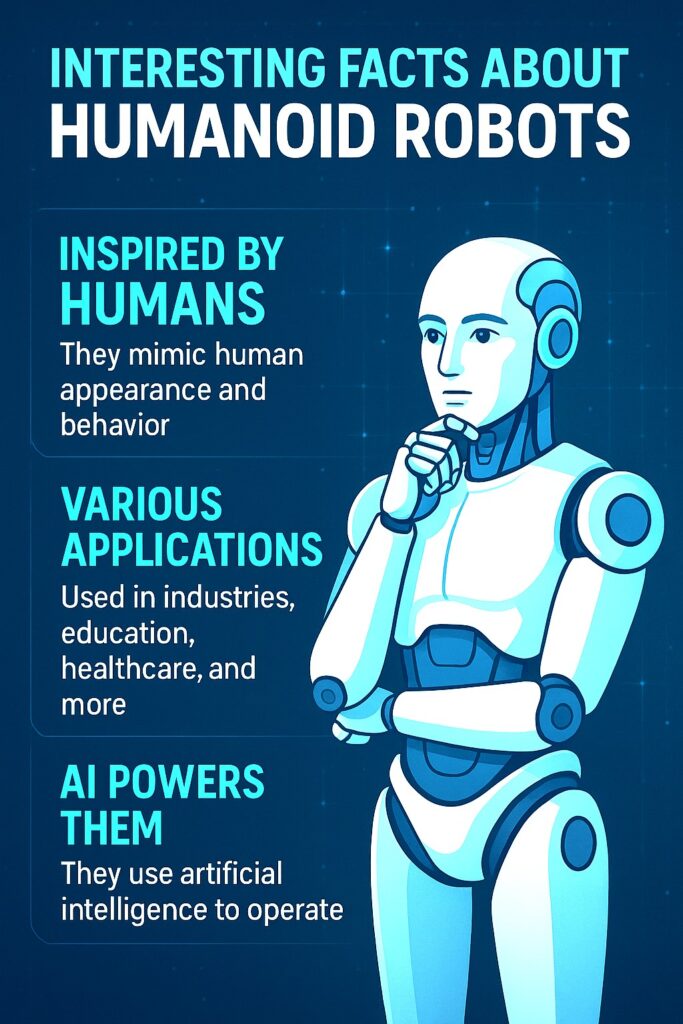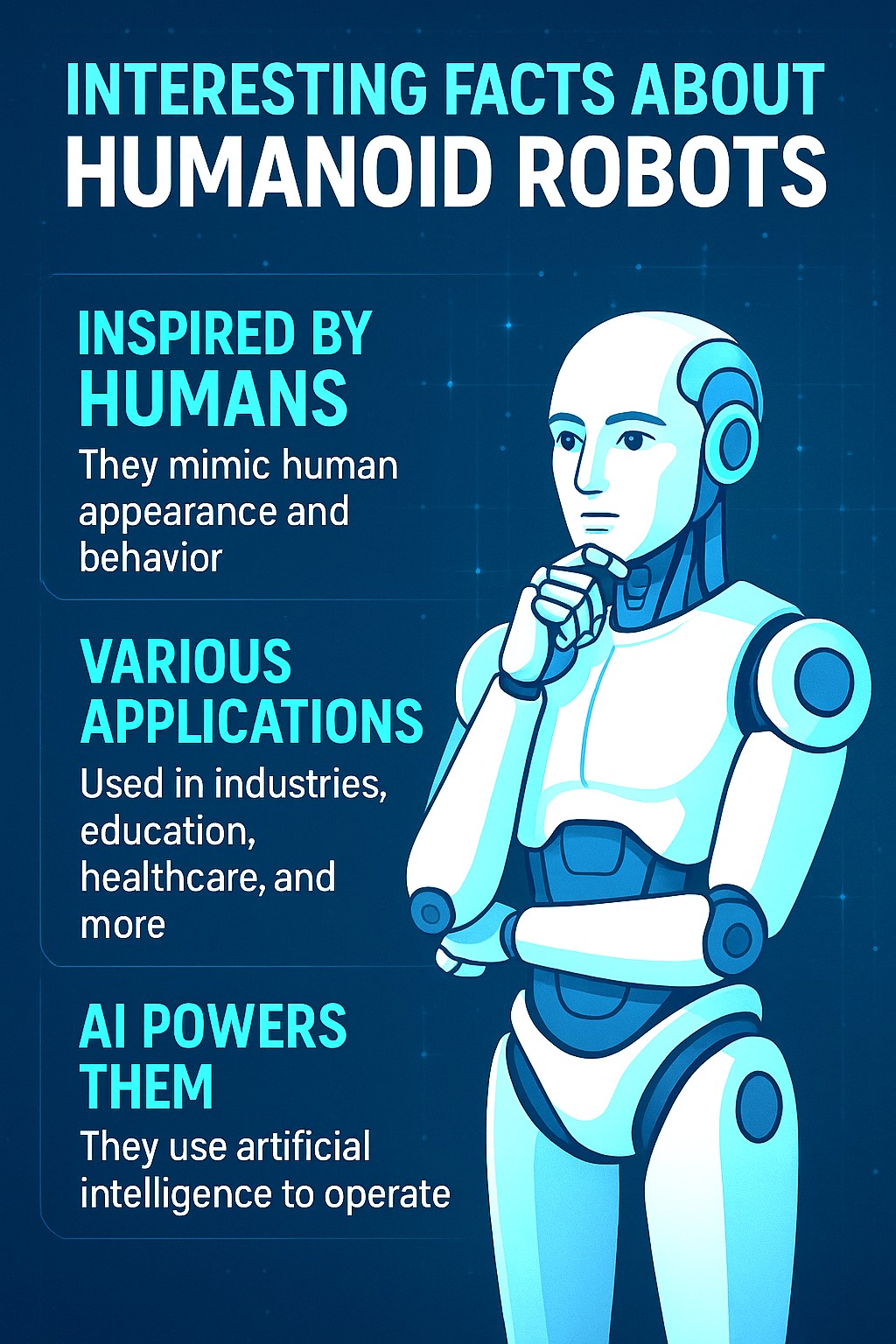Interesting Facts About Humanoid Robots

Humanoid robots have fascinated scientists, engineers, and the general public for decades. With their human-like appearance and ability to perform tasks traditionally associated with people, these machines represent one of the most advanced and exciting branches of robotics. In this article, we’ll explore some of the most interesting facts about humanoid robots—covering their design, capabilities, uses, and future possibilities. All the information provided is factual, based on existing technologies and innovations.
What Are Humanoid Robots?
Humanoid robots are machines designed to resemble and sometimes mimic human appearance and movement. Typically, they have a head, torso, two arms, and two legs—though not all have the full human form. Their purpose ranges from performing physical tasks to serving as companions, researchers, and entertainers. What sets them apart from other robots is their anthropomorphic structure and their ability to engage with human environments and behaviors.
Inspired by the Human Body
One of the most fascinating aspects of humanoid robots is how closely they mirror the human form. Engineers design these machines with joints that mimic shoulders, elbows, hips, and knees. Some advanced models even have facial features and expressive capabilities.
This human-like design isn’t just for aesthetics. It allows the robot to operate in spaces designed for humans, such as offices, homes, and hospitals. Their size, shape, and range of motion help them use tools, climb stairs, and perform tasks that traditional machines cannot handle efficiently.
Real-World Applications
While humanoid robots might sound like science fiction, they are already being used in various sectors:
-
Healthcare: Humanoid robots assist elderly patients, offer companionship, and even help with physical therapy.
-
Education: Schools use them to teach students about robotics, coding, and even to help children with autism develop social skills.
-
Customer Service: Some service robots are used in airports and malls to give directions, answer questions, or provide entertainment.
-
Research: Scientists use humanoid robots to study biomechanics and human-machine interactions.
-
Space Exploration: Their human-like form allows them to operate tools and systems made for astronauts.
These real-world uses are only expected to grow as technology advances.
Controlled by Artificial Intelligence
A major part of what makes humanoid robots so interesting is the AI systems that power them. They are often equipped with advanced artificial intelligence that allows them to recognize speech, detect faces, interpret emotions, and learn from experience.
Some humanoid robots can hold conversations, remember people, and adjust their behavior based on prior interactions. These AI systems use machine learning algorithms and neural networks to continuously improve performance.
By combining AI with mechanical design, engineers are creating robots that are more than just machines—they are interactive agents capable of understanding and responding to human input.
They Are Getting Better at Movement
Early humanoid robots struggled with balance and coordination. Today, thanks to innovations in actuator design and control algorithms, these robots can walk, run, jump, and even dance.
Balance and mobility are essential for working in unpredictable environments. Robots use sensors such as gyroscopes, accelerometers, and vision systems to detect changes in terrain and adjust their posture accordingly.
Some robots now possess the dexterity to perform delicate tasks, such as folding laundry, using tools, or even assisting in surgical procedures. This level of control is a huge leap forward in making robots practical assistants in everyday life.
Human-Robot Interaction (HRI) Is a Key Focus
Humanoid robots are not only designed to function like humans but also to interact with us naturally. Human-robot interaction (HRI) is a field dedicated to studying how humans and robots can communicate and collaborate.
This involves understanding gestures, tone of voice, facial expressions, and body language. Some robots are even programmed to simulate empathy or friendliness by smiling, nodding, or making appropriate facial expressions.
These advancements are essential in building trust between humans and machines, especially in roles that require close cooperation.
Robots Can Learn From Humans
Many humanoid robots are trained using a method known as imitation learning. By watching humans perform tasks, robots can learn to do them too. Cameras, sensors, and AI algorithms help them observe and analyze movements, which they then try to replicate.
This learning method is crucial because it allows robots to adapt to new situations without being explicitly programmed. As they gain more data and experience, their skills improve, making them more useful and versatile.
Ethical Questions and Safety Concerns
With the rise of humanoid robots, ethical questions become increasingly important. For example, how much autonomy should a robot have? Should robots be allowed to make decisions in healthcare or law enforcement?
There are also concerns about data privacy, especially when robots are equipped with cameras and microphones. Ensuring that they are used responsibly is a growing area of research and regulation.
Manufacturers are also developing safety features to prevent harm. These include force sensors to stop movement if the robot bumps into something, emergency shut-off buttons, and programming that prioritizes human safety above all else.
Not All Humanoids Look the Same
Contrary to popular belief, not all humanoid robots are designed to look like real humans. While some aim for realism, others have a more robotic or cartoonish appearance. The design often depends on the robot’s purpose.
For example:
-
In customer service, a friendly and simple design is more approachable.
-
In research or experimental contexts, more realistic appearances help study human reactions to lifelike machines.
The “uncanny valley” effect—when a robot looks almost human but not quite—can create discomfort. Designers work hard to find a balance that is both effective and comfortable for users.
Humanoids Are Not Just for the Rich
Although developing humanoid robots is expensive, efforts are being made to make them more affordable and accessible. Open-source robotics projects and modular robot kits allow enthusiasts and small companies to build their own humanoid robots for research, learning, or entertainment.
As manufacturing costs decrease, we may see humanoid robots becoming more common in homes and schools. Just as personal computers and smartphones became widespread, humanoid robots could follow a similar trajectory in the coming decades.
The Future Looks Human
Looking forward, humanoid robots are expected to play an even greater role in society. They may assist with disaster recovery, act as personal assistants, or even help address labor shortages in aging populations.
Advancements in AI, energy efficiency, and materials science will further improve their abilities. As these robots become more capable and accepted, they could reshape how we think about work, communication, and companionship.
Some researchers envision a future where humans and humanoid robots work side by side, sharing responsibilities and learning from each other. While challenges remain, the potential is enormous.
Conclusion
Humanoid robots are more than just science fiction—they are real, functional, and evolving rapidly. From mimicking human behavior to assisting in healthcare and education, these machines are changing how we interact with technology.
As AI becomes more advanced and robot designs continue to improve, the line between human and machine will blur even further. With continued research, ethical safeguards, and creative innovation, the future of humanoid robots promises to be both helpful and exciting.
Key Takeaways: Interesting Facts About Humanoid Robots
-
Humanoid robots are designed to resemble humans, both in appearance and in the way they move and interact with their environment.
-
They operate using advanced AI technologies, which enable them to recognize speech, understand emotions, and learn from human behavior through imitation and experience.
-
These robots are already used in real-world applications such as healthcare, education, customer service, research, and even space exploration.
-
Their human-like form allows them to work in spaces built for people, making them highly adaptable for everyday environments like homes, offices, and hospitals.
-
Humanoid robots can perform complex physical tasks, including walking, dancing, climbing stairs, and manipulating objects with a high level of precision.
-
Human-robot interaction (HRI) is a growing field that helps improve how robots communicate with people, using gestures, facial expressions, and voice responses.
-
Ethical and safety considerations are critical, especially as these robots become more integrated into society. Responsible use, privacy protection, and safety features are essential in their development.
-
Not all humanoid robots aim to look fully human—some use more stylized or robotic appearances to avoid discomfort and improve approachability.
-
They are becoming more accessible, with open-source projects and affordable kits making humanoid robots available for education and hobbyists.
-
The future of humanoid robots looks promising, with potential roles in personal assistance, disaster recovery, elder care, and collaborative work alongside humans.
Reference
https://en.wikipedia.org/wiki/Humanoid_robot
Link License – https://en.wikipedia.org/wiki/Wikipedia:Text_of_the_Creative_Commons_Attribution-ShareAlike_4.0_International_License
Dear Friends, warmly welcome you to visit link below for more technology articles. Have Fun Reading Them.
https://techsavvo.com/category/blog/


